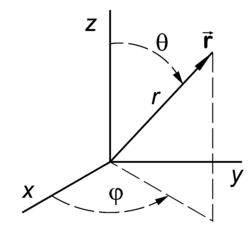Spherical polar coordinates
In mathematics and physics, spherical polar coordinates form a coordinate system for the three-dimensional real space .
Let x, y, z be Cartesian coordinates of a vector in , that is,
where are unit vectors along the x, y, and z axis, respectively. These axes are orthogonal and so are the unit vectors along them.
The length r of the vector is one of the three numbers necessary to give the position of the vector in three-dimensional space. By applying the theorem of Pythagoras twice it follows that r2 = x2 + y2 + z2.
Let θ be the colatitude angle (see the figure) of the vector . In the usual geographic coordinate system used to describe a position on Earth the corresponding latitute angle has its zero at the equator, while the colatitude angle, introduced here, has its zero at the "North Pole", that is, the angle θ is zero when is along the positive z-axis. The sum of latitude and colatitude angle of a point is 900, which explains the name of the latter.
The angle φ gives the angle with the x-axis of the projection of on the x-y plane. The angle φ is the longitude angle (also known as the azimuthal angle).
Note that the projection has length rsinθ. The length of the projection of the latter vector on the x and y axis is therefore rsinθcosφ and rsinθsinφ, respectively. In summary, the spherical polar coordinates r, θ, and φ of are related to its Cartesian coordinates by






